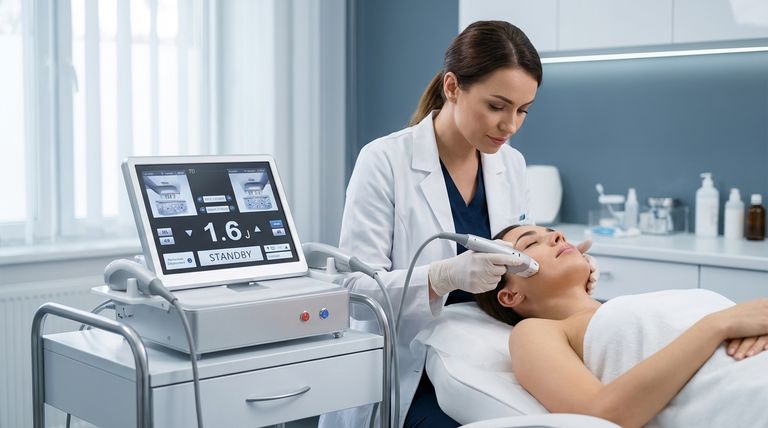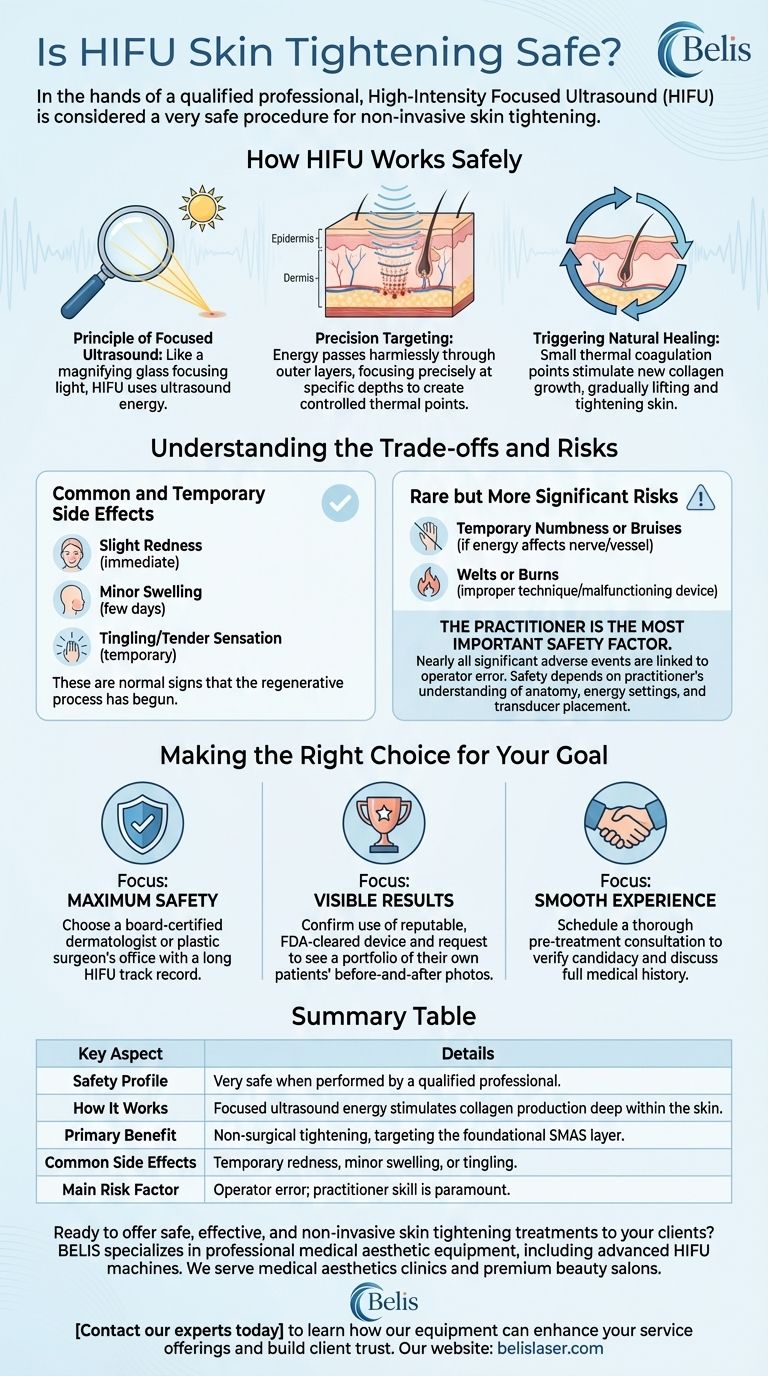In the hands of a qualified professional, High-Intensity Focused Ultrasound (HIFU) is considered a very safe procedure for non-invasive skin tightening. It leverages focused sound waves to stimulate collagen deep within the skin, avoiding the incisions, scarring, and extended recovery time associated with surgical facelifts.
While HIFU has an excellent safety record, its effectiveness and your ultimate safety are not inherent to the technology itself. They are critically dependent on the skill of the practitioner and the quality of the device being used.

How HIFU Works Safely
HIFU is an FDA-cleared procedure that tightens skin on the face, neck, and chest by delivering focused energy to the skin's foundational layers without disturbing the surface.
The Principle of Focused Ultrasound
Think of HIFU like using a magnifying glass to focus sunlight onto a single point. Instead of light, it uses ultrasound energy.
This energy passes harmlessly through the outer layers of your skin. It is then precisely focused at specific depths, creating tiny, controlled points of heat.
Triggering a Natural Healing Response
These small thermal coagulation points trigger your body’s natural regenerative process. The primary response is the production of new, fresh collagen.
Collagen is the protein that gives skin its structure and elasticity. As this new collagen grows over the following weeks and months, it gradually lifts and tightens the skin.
Precision Targeting Without a Scalpel
The true advantage of HIFU is its ability to target the same deep structural layer of skin that plastic surgeons address in a surgical facelift—the SMAS layer.
It does this with extreme precision and without a single incision, which fundamentally eliminates the risks associated with surgery, such as anesthesia complications, infection, and scarring.
Understanding the Trade-offs and Risks
No medical procedure is entirely without risk. While HIFU is significantly safer than surgery, it's crucial to understand the potential side effects.
Common and Temporary Side Effects
The vast majority of side effects are mild and resolve quickly on their own.
These can include slight redness immediately after the procedure, minor swelling for a few days, or a temporary tingling or tender sensation in the treated area. These are normal signs that the regenerative process has begun.
Rare but More Significant Risks
When performed improperly, more serious complications can occur, although they are rare.
These may include temporary numbness or small bruises if the ultrasound energy affects a nerve or blood vessel. In very rare cases, improper technique or a malfunctioning device can cause welts or burns.
The Practitioner Is the Most Important Safety Factor
Nearly all significant adverse events are linked to operator error.
The safety and effectiveness of your treatment depend on the practitioner’s deep understanding of facial anatomy, their ability to select the correct energy settings, and their skill in placing the transducer. Choosing an inexperienced technician is the single greatest risk.
Making the Right Choice for Your Goal
To ensure a safe and effective treatment, your focus should be on vetting the provider, not just the technology.
- If your primary focus is maximum safety: Choose a board-certified dermatologist or plastic surgeon's office with a long track record of performing HIFU treatments.
- If your primary focus is achieving visible results: Ask the clinic to confirm they use a reputable, FDA-cleared device and request to see a portfolio of before-and-after photos of their own patients, not stock images.
- If your primary focus is a smooth experience: Schedule a thorough pre-treatment consultation to verify you are an ideal candidate and openly discuss your full medical history.
By prioritizing the expertise of the provider, you take the most important step toward ensuring a safe procedure and a successful outcome.
Summary Table:
| Key Aspect | Details |
|---|---|
| Safety Profile | Very safe when performed by a qualified professional. |
| How It Works | Focused ultrasound energy stimulates collagen production deep within the skin. |
| Primary Benefit | Non-surgical tightening, targeting the foundational SMAS layer. |
| Common Side Effects | Temporary redness, minor swelling, or tingling. |
| Main Risk Factor | Operator error; practitioner skill is paramount. |
Ready to offer safe, effective, and non-invasive skin tightening treatments to your clients?
BELIS specializes in professional medical aesthetic equipment, including advanced HIFU machines. We serve medical aesthetics clinics and premium beauty salons, ensuring you have the reliable technology needed for outstanding results and client safety.
Contact our experts today to learn how our equipment can enhance your service offerings and build client trust.
Visual Guide

Related Products
- 7D 12D 4D HIFU Machine Device
- 12D HIFU Machine Device for Facial HIFU Treatment
- 4D 12D HIFU Machine Device for Skin Tightening and Lifting
- 4D 12D HIFU Machine Device for Skin Tightening
- Hydrofacial Machine with Facial Skin Analyzer and Skin Tester
People Also Ask
- How long does it take for HIFU to show results? See the Dual-Phase Timeline for Natural Lifting
- What are the benefits of HIFU machine? Achieve Non-Surgical Skin Lifting & Tightening
- How long does it take for HIFU to start working? See Full Results in 2-3 Months
- What is the best frequency for HIFU treatment? Achieve Lasting Lifting & Tightening Results
- How do I maximize my HIFU results? A Guide to Optimal Lifting and Tightening



















